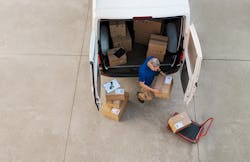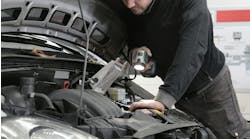Mike Dooley’s mentality has evolved over the course of 42 years spent in the auto industry. More than one viewpoint from the late 1970s has given way to the hindsight of today.
“I used to, for years, hate the word ‘processes,’” says Dooley, the parts director for Michigan’s LaFontaine Automotive Group. “You know, ‘you have to have a follow-up process.’”
Roughly a decade ago, though, Dooley began overseeing a massive warehouse in suburban Detroit. All of a sudden, getting employees to efficiently follow procedures became a necessity for survival. Especially when it came to delivering parts. Because Dooley currently oversees 16 total rooftops for the LaFontaine group—and the nearly $10 million in inventory that comes with that role.
Keeping 146 total employees on the same page—and setting aside parts in an orderly fashion, so they can be delivered quickly—is even harder than it sounds. Dooley became painfully aware of that when he was charged with overseeing a massive, 108,000-square-foot central warehouse.
If employees simply toss parts in the back of the warehouse hurriedly, disorganization can run rampant in a parts department.
And, Dooley notes, “at the end of the day, it’s the customer that pays” for such carelessness.
“I expect everyone to follow their processes” nowadays, he notes. “It’s a daily thing we have to never let up on.”
A Stalled Situation
By earlier this decade, Dooley was tasked with overseeing 16 rooftops—a number that not only included that sizeable central warehouse, but also an overstock warehouse.
That meant that LaFontaine’s parts drivers needed to be especially efficient, to keep the auto group’s countless deliveries orderly.
Yet, for myriad reasons, that didn’t happen consistently. Perhaps a parts “picker,” as Dooley calls them, placed collision repair parts on an incorrect shelf. Or, perhaps those same employees placed one order of parts on top of another, leaving a heaping pile of disorganization in their wake. Or, perhaps a parts driver neglected to carefully check his or her invoice before leaving the warehouse.
All those issues combined to cause “daily struggles” for parts drivers, Dooley says.
Recalling those problems makes irritation apparent in his voice.
“You can’t, for lack of a better term, just throw [parts] on the route,” Dooley says, because, “you’re just making the next guy’s job more difficult.”
Surging Forward
Eventually, Dooley came to a conclusion about what was holding back his staff.
“It came down to three things: caring, respect, and pride,” he explains. Staff members “all have to respect what they do, and respect the person that they’re affecting.
“And that’s a difficult thing, getting your people to care.”
These days, however, Dooley takes great care to educate his employees on the precise procedures he wants followed, especially with regard to parts deliveries. And, for a man who once hated the term “processes,” he has created some awfully effective ones in eastern Michigan.
Currently, LaFontaine assigns every customer a parts delivery route, adding up to 22 different routes. Twenty-eight delivery trucks are utilized. Dooley has ensured that parts flow efficiently in and out of his shipping docks in suburban Detroit by utilizing a series of shelves that are dedicated to the aforementioned delivery routes.
His facility has a small parts bin placed right alongside a bulk parts bin. And, ultimately, when a employee picks a part, they label it with an invoice number and the specific route number, before placing it in the appropriate staging area.
As long as each employee focuses on their specific roles, the delivery process now operates like clockwork under Dooley’s watch.
“Everyone was assigned processes, and if everyone doesn’t follow the process, it causes a problem and sticks out,” he says. But, “I don’t browbeat my people. I educate them.
“It’s been proven to me that, because of human nature, people that are seeing that they’re making mistakes will strive to stop making mistakes.”
And, in late 2018, the issues are few and far between for LaFontaine’s parts crew. Several factors led to that delivery success, such as:
- Ample room was dedicated to staging parts. “If you think you need 20 square feet, you need 30,” Dooley says of parts staging areas. “As parts managers … we’re used to packing everything in all nice and tight, [but] you have to leave a sufficient amount of space.”
- Pickers handle parts paperwork carefully. Order, Dooley notes, is an imperative element of the parts delivery process. “A key is that everyone labels things legibly, because the drivers have to be able to read those labels,” he says.
- Drivers are chosen carefully. While the role of a parts driver doesn’t require extensive education, Dooley won’t just hire anyone and place them on a route. He doesn’t hire frequent job hoppers, for example, and he seeks out employees with an exemplary work ethic; he has had good luck hiring retirees (even including a few former executives) recently. “We like the guy that comes in that’s in his late 50s, early 60s, and wants to work a few years,” Dooley notes. “They tend to have a different work ethic than the youth of America.”
Rearview Reflection
Dooley’s procedures have been refined. His parts departments at LaFontaine are thriving, with a total inventory that recently reached eight figures.
He’ll never again doubt the value of putting processes in place.
“Say you just picked a 20-piece order,” Dooley explains. “You can’t just throw [parts] down and have it spread all over the whole area. Because there’s going to be someone right behind you with an order. So, you have to stack it neatly.
“It comes down to caring.”


